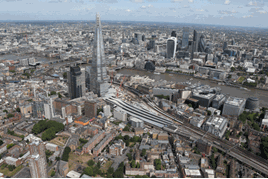It’s a time of transition at London Bridge. The station is in the middle of rebuilding as part of the £6 billion Thameslink project, with the number of through platforms increased and the number of terminating platforms decreased, as well as the gradual decommissioning of the old signal box.
By August 2016, there will effectively be a brand new station, with a concourse the size of the football pitch at Wembley Stadium.
This will provide enormous benefits in terms of cross-London rail capacity (according to Office of Rail and Road station usage statistics, in 2013-14 the number of people using London Bridge totalled more than 56 million), but it is not without its frustrations, not least for regular passengers and staff. Right now, there are pressing operational issues.
“At 0830 a train can be two-three minutes late, and it is impossible to recover the service,” says Local Operations Manager Roy Lamb.
Things have been made slightly easier with the introduction of the Tanners Hill fly-under, which has allowed parallel moves. “New track has made a difference,” says Lamb.
On the day of RAIL’s visit, Platforms 1-3 and 6-9 were all in use while the remainder were being rebuilt, with gaping voids in the spaces where trains once stood. They will return to service gradually as the Thameslink programme is completed, but the entire complement of platforms will not be reinstated until 2018.
Signallers have a challenge to weave in Southeastern, Southern and Thameslink trains, although the new Bermondsey ‘dive under’ (RAIL 725) will help to alleviate this. They are also trying not to divert to Cannon Street or Charing Cross at times of disruption, to avoid an impact on those stations “as it affects individual performance”, says Network Rail Area Manager for Kent David Davidson.
When London Bridge signal box is decommissioned, it will become merely a relay room for signalling - the panels will no longer be needed as control will be taken over by Three Bridges Route Operating Centre. The relay room at trackbed level is like something that might have first been revealed on a 1970s edition of Tomorrow’s World. Lamb reckons there are “approximately 600” relays in this room, clattering and clicking away (or at least that’s the figure he was told when he first started working at London Bridge around 15 years ago).
Since then, some relays have been replaced by Solid State Interlocking technology, which Lamb describes as “exceedingly reliable”.
Over at Southwark Bridge Road, where Network Rail and Southeastern share a control room (the building also accommodates other train operators), remote condition monitoring technology is in use in order “to get to infrastructure assets before they fail”, according to the staff member responsible.
Points, point heaters, relay room temperatures and level crossings can all be monitored, among other elements of the operational railway. The aim is to identify data and to analyse fault conditions within that data. Even the temperature of the rail itself can be measured.
In charge is Network Rail Route Control Manager Tom Giddings, who has shift responsibility for Southeastern staff.
“The peak’s shaping up well so far,” he tells RAIL. (At 0847 on June 25, the Kent route is recording a Public Performance Measure of 98%.)
“The Charing Cross run through has improved performance,” he adds, pointing to a colour-coded screen. “Yellow indicates a train that is under ten minutes late. Red is over ten minutes”. (Fortunately, there are few red blobs.) Giddings tells RAIL that the biggest impact on service delivery is trespassers.
Train running controller Nicola Price works with both passenger operators and freight operating companies.
“If anything goes wrong I pick up the pieces,” she tells RAIL. Price will deal with unusual moves, and with control rooms across the country. It’s her job to know what moves are available - and it’s not easy to path one-off trains through one of the busiest rail networks in the world.
Incident Controller Bob Goodwin deals with train defects, trespass, level crossing incidents, or even incidents such as when a disabled person is using a level crossing while the barriers are coming down - incidents that necessitate a speedy response.
“An incident is anything that stops trains running to schedule. Or a risk to the public or the railway,” he explains.















Login to comment
Comments
No comments have been made yet.